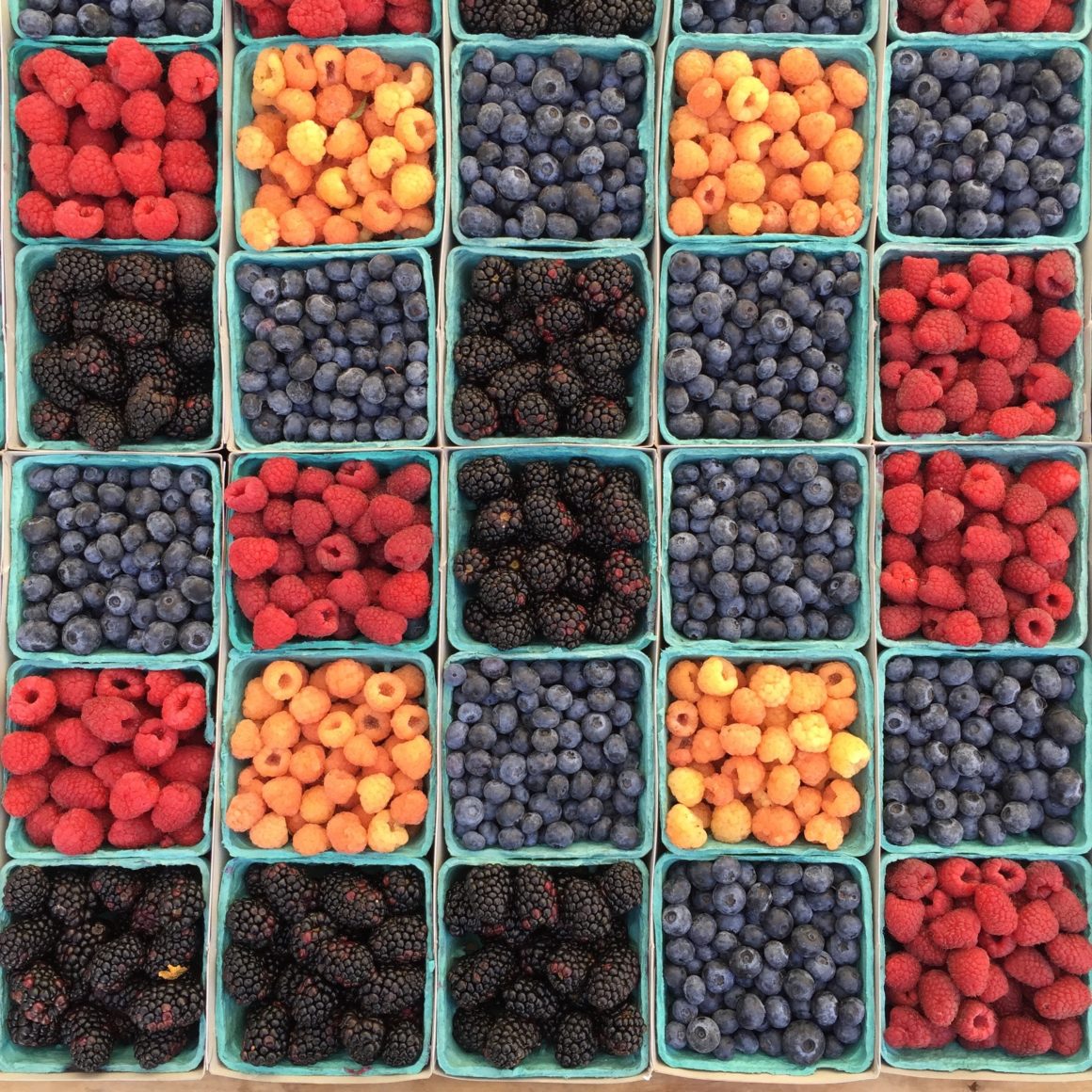
Berry Goodness Year-Round
As a kid growing up in Oregon, the berry fields were where I earned my money throughout the summer. When I close my eyes and let my mind drift, I remember myself rolling out of bed at dawn, throwing on old jeans and a T-shirt and running out into the chilly morning air to catch a ride with my friend, Lisa, whose mother would drop us off at the berry field, where Lisa and I would compete to see who could make the most money each day. I can still smell the sweet scent of the strawberry fields, see the bright red berries bursting from the lush plants that stretched for acres all around us and taste the sweet juice dripping from my lips after biting into one of those freshly-picked ruby-red jewels. Strawberries came first, then raspberries, blackberries, and blueberries. Of course, in Oregon, I was lucky enough to have all the boysenberries, marionberries, huckleberries, and black caps (aka black raspberries) I could eat as well! Believe it or not, there are a host of other berries grown in Oregon that I haven’t even mentioned, but I’ll leave that for you to Google😊
Now, as a kid, munching berries in the strawberry patch, it didn’t occur to me beyond the immediate gratification of eating one and the satisfaction of the cash in my pocket when Mom retrieved me from the field in the afternoon, that berries have so much more to offer. Not only are they gloriously colorful and delectably sweet they are a dietitian’s dream when it comes to nutrition and a chef’s delight when it comes to the complex flavors, texture, and beauty they bring to the dining experience. Fresh, frozen, or dried, blended into smoothies, simmered in sauces, dropped into salads, displayed on cheese platters, or even served in grain or meat entrees, they can make even the simplest dish appear elegant.
Having a lower glycemic index and glycemic load, berries don’t cause the same spike in blood sugars seen with many other fruits such as bananas, grapes, and pineapple. That said, berries can fit nicely into keto and low-carb diets, and can be easily integrated into the diets of individuals with diabetes. Their high fiber content also helps minimize their impact on blood sugars while providing a sense of fullness and helping maintain normal bowel function. Berries are high in Vitamin C, important for the formation of collagen, absorption of iron, support of the immune system, wound healing, and the maintenance of cartilage, bones, and teeth. There is also strong evidence suggesting that, with their high antioxidant content, berries may play a role in protecting against cancer and other chronic diseases including diabetes, heart disease, and Alzheimer’s.
Few things rival ripe, juicy berries beckoning to you from their pint-size baskets as they glisten in the bright summer sun at your local farmer’s market. Wouldn’t it be nice if we could enjoy berries like this year-round? Well, at least here in Chicago, and most places in North America, that isn’t an option, but that doesn’t mean we can’t still indulge in berry goodness throughout the cold months of the year! While it costs more and doesn’t give us that warm satisfaction of knowing we’re supporting our local farmers, we can have them shipped from Mexico, Peru, and Chile. And, while opening a bag of raspberries quickly snatched from the freezer can’t compare with plucking a fresh handful from the vine, frozen berries still offer high nutritional value, versatility in recipes, and pure yum. Now, I’ll admit frozen berries don’t work so well in a salad (they pretty much turn to mush when they thaw), but they work great if you’re planning to blend, marinate, or cook them. In fact, many will argue frozen berries are preferred when making a smoothie. Dried berries can also be enjoyed year-round, but keep in mind with most of the water removed, the sugar content in a quarter cup of dried berries is going to be significantly higher than in a quarter cup of fresh or frozen. They’re still packed with nutrition and super convenient, so enjoy them, but in smaller quantities.
I’m sure if you think about it, you’ve got some great ideas of how to increase your intake of this flavorful, nutrient-rich food, and I’m going to ask you to PLEASE SHARE YOUR IDEAS at the end of this post! To get your creative juices flowing, I’m going to share a few ideas of my own for how to brighten your meals with fresh, frozen, and dried berries.
Fresh Berries:
- Spread a Maria’s Biscuit (you can find these Goya brand biscuits in the Mexican/Spanish aisle of the grocery store) with a thin layer of cream cheese. Place a mélange of raspberries, blackberries, and sliced strawberries atop the cream cheese. Top with a very light dusting of confectioner’s sugar. Voila! You have a beautiful, sweet, yet light dessert for you and your guests!
- Toss a handful of arugula in a bowl. Drop a scoop of blackberries and dozen or so hazelnuts in, and crumble fresh feta over the nuts and berries. Drizzle with a bit of olive oil. Give it a splash of Balsamic vinegar, and sprinkle with fresh cracked pepper. There you have it! A light lunch or a dinner salad!
- Replace that sugary Yoplait “stuff” with a thick, plain Greek yogurt (I, personally, like Fage brand or my own homemade) topped with a mix of whatever fresh berries are on sale this week. Drizzle lightly with high-quality honey (there really is a huge difference in flavor) or sprinkle with a little monk fruit sweetener. Mmmm…a nutritious breakfast you actually DO have time to make.
Frozen Berries:
- Frozen berries are PERFECT for smoothies, and who doesn’t like smoothies???
- Frozen berries work great in sauces or purees. If you like sweet and savory, you MUST try a raspberry sauce over warm Brie. I’m so sorry. I wanted to share my own recipe for raspberry sauce this week, but it needed some more testing in the kitchen 😊 You can find many recipes for raspberry sauce on the internet, but be sure to look for ones lower in sugar. You’ll find with the savory contrast of the Brie, you won’t need a lot of sugar for the raspberry sauce to still taste sweet.
- Soup doesn’t always have to be hot. If you’re missing summer, whip up a batch of strawberry soup. Simply thaw your frozen berries and puree in your blender with some plain yogurt and a little honey or monk fruit sweetener. Try adding a little sour cream with a splash of orange juice or a squeeze of fresh lemon juice to increase the flavor complexity, and then garnish with fresh mint or thyme leaves. This makes a beautiful side for your lunch salad, a simple yet unique and classy dessert for your guests, or a breakfast that makes you feel like you should feel guilty!
Dried Berries:
- What to do with that leftover quinoa? Warm it up with some dried blueberries and your favorite plant milk, and top with a dash of cinnamon sugar and chopped walnuts or almond slices. Now you can say goodbye to plain, boring hot cereal.
- You may have figured out by now that I’m vegetarian, but if you’re not, you really ought to try adding some dried berries to that next chicken and rice dish you serve. The sweet-tart dried berries will soak up the savory broth from your chicken and burst with flavor in every bite!
- Make your own “trail mix” for a snack on the go this week. Mix a bit of dried berries (pick your favorite) with a little cacao nibs along with some unsweetened coconut, sunflower seeds, almonds, pecans, and walnuts (or whatever other nuts you enjoy). Scoop quarter cup servings into reusable sandwich bags or small plastic containers with lids and store in your pantry. Grab and go!
Okay, your turn! If you’ve got a recipe or an idea of your own, please share it in the comments below.
Thank you and have a “berry” good day!






6 Comments
Kerry
Hello!
Great information.
Do you have a YouTube link?
nainsworth44
Hi Kerry. Thanks for asking! I do indeed! It is https://www.youtube.com/channel/UCf46SMM6gkoFWf8i0931U_g If you enjoy the videos, please subscribe, and let me know if there are topics you’d be interested in seeing in the future!
Ty Miller
I go through a lot of frozen berries myself. Typically I use them to make my breakfast smoothies. I also switch it up from time to time and make fresh plain oatmeal for breakfast or a snack and put frozen berries on top as a natural way to sweeten it up! An adult beverage like mimosas is another great option where you can replace the orange juice with a few frozen berries, they add color and have no added sugar unlike most orange juices.
nainsworth44
Hi Ty! Thanks so much for your reply. I like your breakfast idea and berries indeed make “adult beverages” beautifully colorful and are a lower sugar option if you’re using them in place of mixers!
Kevin
Thanks Nicole for another informative and entertaining post. I love all kinds of fruit so this post is close to my heart. I particularly love Blueberries and eat them throughout the day instead of snack food. I have heard but don’t know it to be true that if I dehydrate fruit that it increases the sugar content and thereby losing the health benefits of fruit. Is that true?
nainsworth44
Hi Kevin, Great to hear from you again! I love to hear that you are substituting antioxidant and fiber-rich blueberries for empty-calorie, sugary, and/or processed snack foods. Dehydrating fruit doesn’t actually increase the sugar content of the berries. Because you are removing the water from the fruit when you dehydrate it, the sugar becomes more concentrated, such that quarter cup of fresh blueberries that are plump and juicy due to the high water content is higher in sugar content than a quarter cup of dried blueberries, which have a much lower water content. Happy, healthy snacking!